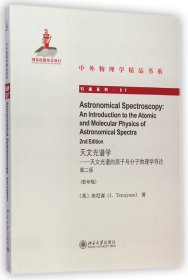
天文光谱学--天文光谱的原子与分子物理学导论(第2版影印版)/引进系列/中外物理学精品 9787301251706
全新正版 可开票 支持7天无理由,不清楚的请咨询客服。
¥ 26.22 6.4折 ¥ 41 全新
仅1件
浙江嘉兴
认证卖家担保交易快速发货售后保障
作者(英)坦尼森
出版社北京大学
ISBN9787301251706
出版时间2014-12
装帧其他
开本其他
定价41元
货号3092910
上书时间2024-03-24
- 最新上架
商品详情
- 品相描述:全新
- 商品描述
-
目录
Preface
1.Why Record Spectra of Astronomical Objects?
1.1 A Historical Introduction
1.2 What One Can Learn from Studying Spectra
2.The Nature of Spectra
2.1 Transitions
2.2 Absorption and Emission
2.3 Other Measures of Transition Probabilities
2.4 Stimulated Emission
2.5 Optical Depth
2.6 Critical Density
2.7 Wavelength or Frequency?
2.8 The Electromagnetic Spectrum
3.Atomic Hydrogen
3.1 Overview
3.2 The Schrodinger Equation of Hydrogen-Like Atoms
3.3 Reduced Mass
3.4 Atomic Units
3.5 Wavefunctions for Hydrogen
3.6 Energy Levels and Quantum Numbers
3.7 H-Atom Discrete Spectra
3.8 H-Atom Spectra in Different Locations
3.8.1 Balmer series
3.8.2 Lyman series
3.8.3 Infrared lines
3.9 H-Atom Continuum Spectra
3.9.1 Processes
3.9.2 H-atom emission in H II regions
3.10 Radio Recombination Lines
3.11 Radio Recombination Lines for Other Atoms
3.12 Angular Momentum Coupling in the Hydrogen Atom
3.13 The Fine Structure of Hydrogen
3.14 Hyperfine Structure in the H Atom
3.15 Allowed Transitions
3.16 Hydrogen in Nebulae
4.Complex Atoms
4.1 General Considerations
4.2 Central Field Model
4.3 Indistinguishable Particles
4.4 Electron Configurations
4.5 The Periodic Table
4.6 Ions
4.7 Angular Momentum in Complex Atoms
4.7.1 L-S or Russell-Saunders coupling
4.7.2 j-j coupling
4.7.3 Why two coupling schemes?
4.8 Spectroscopic Notation
4.9 Parity of the Wavefunction
4.10 Terms and Levels in Complex Atoms
5.Helium Spectra
5.1 He I and He II Spectra
5.2 Selection Rules for Complex Atoms
5.3 Observing Forbidden Lines
5.4 Grotrian Diagrams
5.5 Potential Felt by Electrons in Complex Atoms
5.6 Emissions of Helium-Like Ions
6.Alkali Atoms
6.1 Sodium
6.2 Spin-Orbit Interactions
6.3 Fine Structure Transitions
6.4 Astronomical Sodium Spectra
6.5 Other Alkali Metal-Like Spectra
7.Spectra of Nebulae
7.1 Nebulium
7.2 The Bowen Mechanism
7.3 Two Valence Electrons
7.4 Autoionisation and Recombination
8.Spectra in Magnetic Fields
8.1 Uniform Magnetic Field
8.2 Strong Magnetic Field
8.3 Weak Magnetic Field
8.3.1 The normal Zeeman effect
8.3.2 The anomolous Zeeman effect
8.4 Spectra in Magnetic Field
9.X-Ray Spectra
9.1 Inner Shell Processes
9.2 The Solar Corona
9.3 The Structure of Highly Ionised Atoms
9.4 Isotope Effects
10.Molecular Structure
10.1 The Born-Oppenheimer Approximation
10.2 Electronic Structure of Diatomics
10.2.1 Labelling of electronic states
10.2.2 Symmetry
10.2.3 State labels
10.3 Schrodinger Equation
10.3.1 Nuclear motion in diatomic molecules
10.4 Fractionation
10.5 Vibration-Rotation Energy Levels
10.6 Temperature Effects
10.6.1 Rotational state populations
10.6.2 Vibrational state populations
10.6.3 Electronic state populations
11.Rotational Spectra
11.1 Rotational Structure of Polyatomic Molecules
11.2 Selection Rules: Pure Rotational Transitions
11.3 Selection Rules
11.4 Isotope Effects
11.5 Rotational Spectra of Other Molecules
11.6 Rotational Spectra of Molecular Hydrogen
11.7 Maser Emissions
12.Vibration-Rotation Spectra
12.1 Vibrations in Polyatomic Molecules
12.2 Vibrational Transitions
12.2.1 Structure of the spectrum
12.2.2 Isotope effects
12.2.3 Hydrogen molecule vibrational spectra
12.3 Astronomical Spectra
13.Electronic Spectra of Diatomic Molecules
13.1 Electronic Transitions
13.2 Selection Rules
13.2.1 Vibrational selection rules
13.2.2 Rotational selection rules
13.3 Transition Frequencies
13.4 Astronomical Spectra
13.5 Non-E Electronic States
Solutions to Model Problems
Further Reading and Bibliography
Index
内容摘要
对于宇宙的观测,其信息几乎都来自于光。观测一方面要把光分解成各种成分,另一方面也要了解原
子和分子的性质。坦尼森编著的《天文光谱学:天文光谱的原子与分子物理学导论(第2版影印版)》对于这两方面都进行了系统讲述。在天文光谱学的研究中,本书能够提供丰富而实用的知识。
本书适合天文学领域的研究者和研究生阅读。
— 没有更多了 —












以下为对购买帮助不大的评价